As someone who has born witness to the last decade of Commander, I have seen a lot of fads and deck-building principles come and go. Prominently, the frequent influx of new staples into Commander has created an environment where a deck surviving in any form for more than a few years has become a bit of an outdated concept. While I don’t think continuity with a deck is something that is essential to appreciating Commander, I have personally gotten a lot of joy out of exploring old concepts through the lens of new cards on a semi-annual basis. This is what has allowed decks like Doran, the Siege Tower, Shattergang Brothers, and the subject of today’s discussion, Ib Halfheart, Goblin Tactician to stick around as ever-evolving decks for most of the last ten years.
Whereas other goblin generals have entered into the format and really stolen the spotlight from my favorite tactical mastermind, I have never chosen to seriously consider them as the appropriate replacements for the old veteran. To me, Ib captures a lot of what I love about the Goblin tribe, even if they don’t make for the most consistent build. Today, I want to talk about what makes the deck so nostalgic for me, how the deck has evolved from its dormant state a year ago, and talk about some hidden gems.
This deck is a celebration of goblins. While a lot of people are very aware of them due to their iconic appearances from planes like Ravnica, Lorwyn, Mirrodin, and Ixalan; to best outline what I mean, I think we need to look at an unfiltered and complete examination of their history.
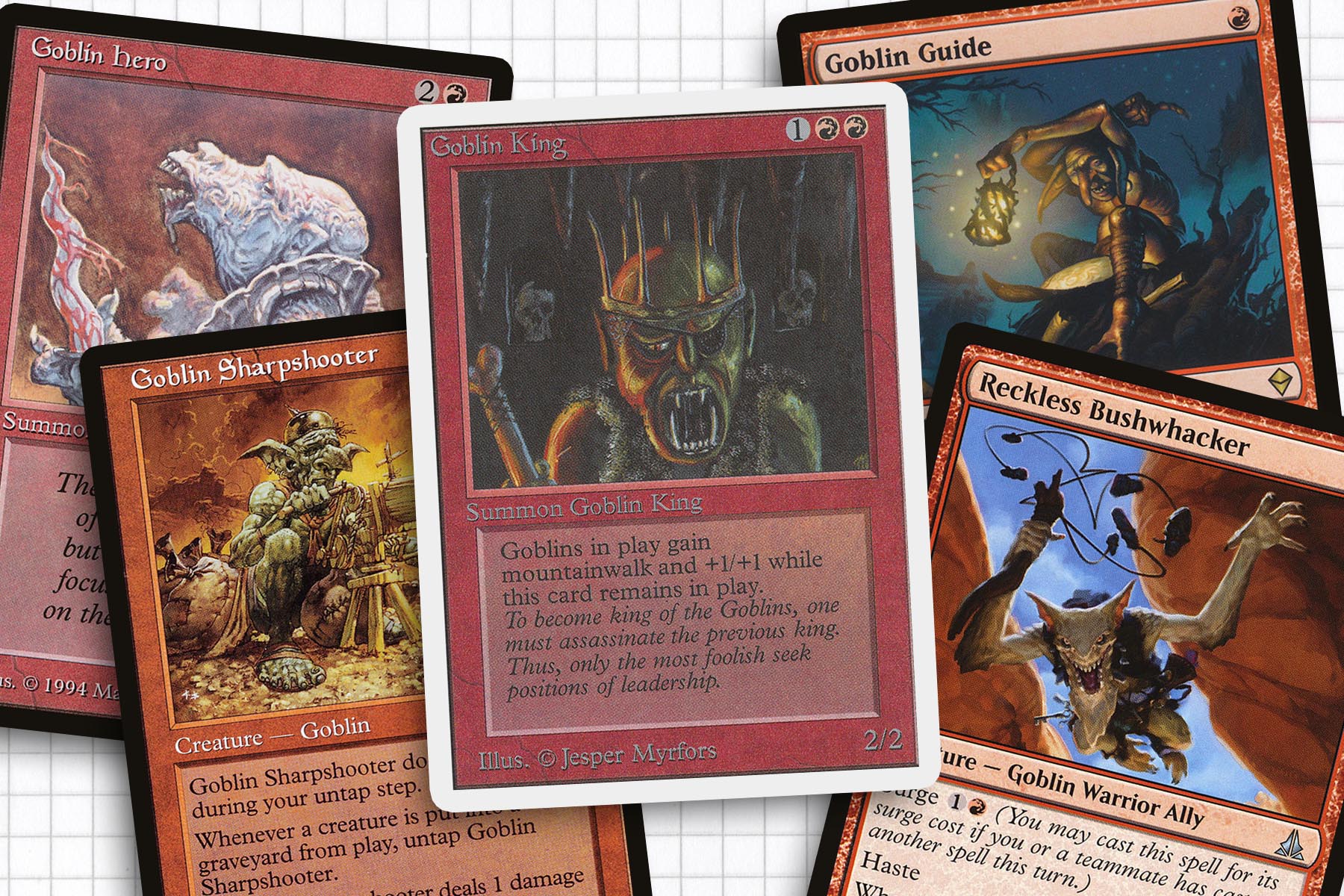
An Ib-Complete History of Goblins
From the very beginning, Goblins were given the tribal treatment in Alpha with a lord-effect in Goblin King, who was joined by Lord of Atlantis and Zombie Master. While maybe not the most crucial building block of Magic, I think the existence of tribal incentives in Alpha was an important element to solidify it as a part of the history of the game. With only Goblin Balloon Brigade and Mons’s Goblin Raiders, the Goblin tribe had humble origins and by all accounts was not as competitively viable as its counterpart, merfolk. Still, there was a built-in incentive to collect goblins and put them into decks together.
While it’s hard to debate that the printing of Goblin Lackey and Goblin Matron brought legitimacy to a possible competitive goblins deck in Constructed formats, Onslaught Standard brought the tribe into Competitive Constructed in a big way. The printing of Gempalm Incinerator, Goblin Piledriver, Goblin Warchief, Siege-Gang Commander, and Skirk Prospector all within a year of each other meant that the metagame for a time could be summed up as “Goblins and Something that could beat Goblins.”
Goblins would make appearances across many planes in the multiverse, but it wasn’t until our second trip to Zendikar that a proper return of Goblins would occur. Goblin Bushwhacker and Goblin Guide were stand out cards in 2009, but the printing of Reckless Bushwhacker in 2016 allowed for the creation of the 8-Whack in Modern. From there, Goblins have come in and out of relevance in Standard, with a high point during Dominaria, and has had a constant presence in Legacy.
Of course, Commander has been and will likely continue to be a thriving home for the goblin tribe. Commander allows the tribe to be expressed in a myriad of ways and gives their spot in the format a lot of staying power. We can see a lot of strategic diversity, even just among the current top five Goblin generals: Krenko, Mob Boss, Wort, Boggart Auntie, Muxus, Goblin Grandee, Gut, True Soul Zealot with Haunted One, and Purphoros, God of the Forge. Goblins often go wide, can be hard to keep down, and play a very accelerated game.
If I wasn’t so attached to Ib Halfheart, I think I would most likely have built around another popular goblin just outside of the top five, Zada, Hedron Grinder, expressing the unpredictability of the tribe in a very unique build. Of course, I am a creature of habit and have not given up on my long-existing Commander deck, so let’s examine the deck in full.
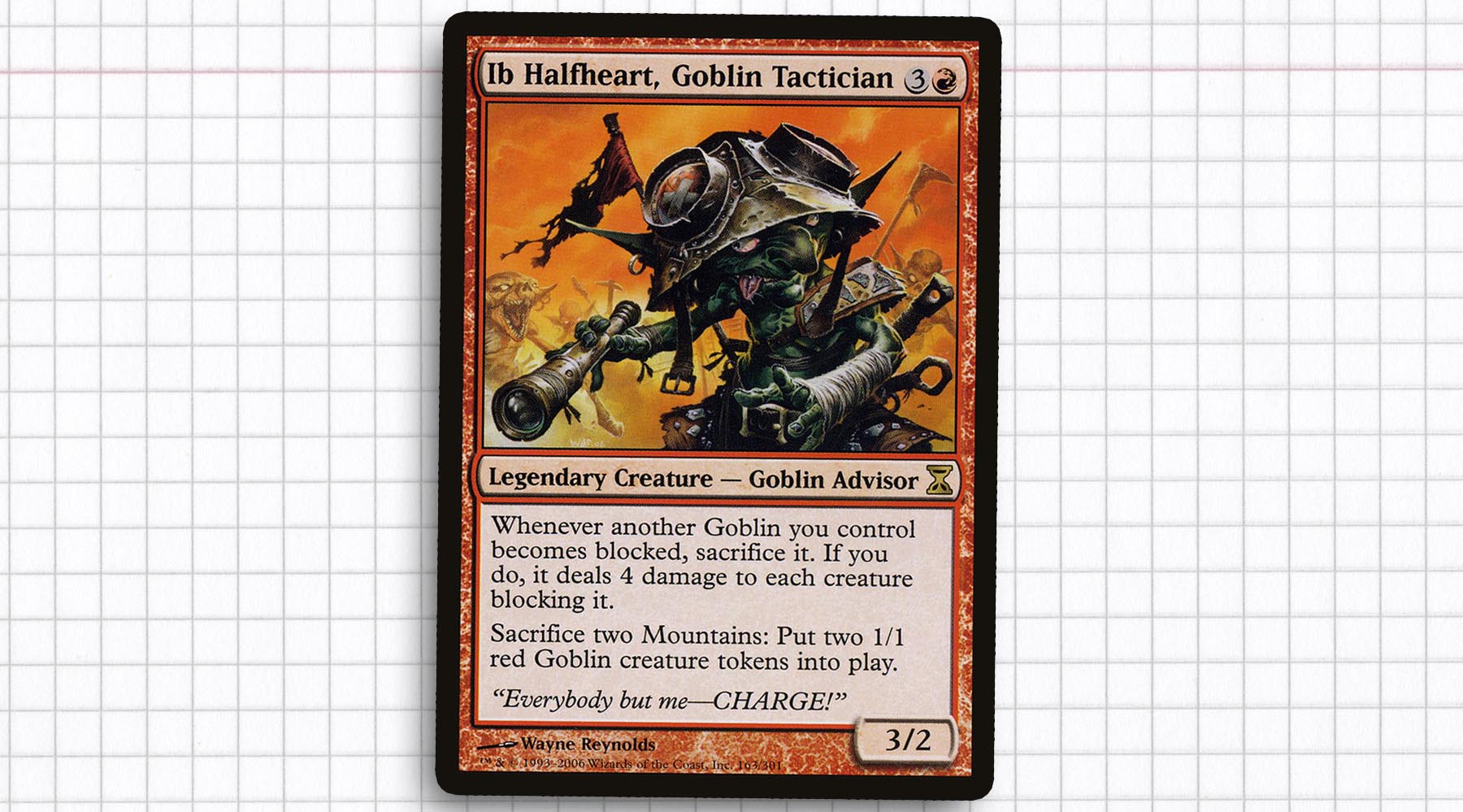
Commander: Ib Halfheart, Goblin Tactician
Planeswalker: Daretti, Scrap Savant
Creatures: Anger, Battle Cry Goblin, Birgi, God of Storytelling, Caterwauling Boggart, Goblin Chainwhirler, Goblin Chieftain, Goblin Chirurgeon, Goblin Grappler, Goblin King, Goblin Matron, Goblin Piledriver, Goblin Recruiter, Goblin Ringleader, Goblin Trashmaster, Goblin Warchief, Grenzo’s Ruffians, Grenzo, Havoc Raiser, Hobgoblin Bandit Lord, Krenko, Mob Boss, Neheb, Dreadhorde Champion, Pashalik Mons, Siege-Gang Commander, Skirk Fire Marshal, Skirk Prospector, Stingscourger, Treasonous Ogre
Artifacts: Caged Sun, Heirloom Blade, Lightning Greaves, Skullclamp, Sol Ring, Surveyor’s Scope, Traveler’s Amulet, Vedalken Orrery, Worn Powerstone
Enchantments: Breath of Fury, Goblin War Drums, Mana Echoes, Outpost Siege, Shared Animosity, Shivan Harvest, Vicious Shadows
Instants: Battle Hymn, Brightstone Ritual, Cathartic Pyre, Chaos Warp, Into the Core, Thrill of Possibility, Unexpected Windfall
Sorceries: Chain Reaction, Disrupt Decorum, Earthquake, Empty the Warrens, Ghired’s Belligerence, Ignite the Future, Mob Rule, Red Sun’s Zenith, Reforge the Soul, Wheel of Fate
Lands: 34 Mountain, Dust Bowl, Ghost Quarter, Path of Ancestry, Strip Mine, Tectonic Edge
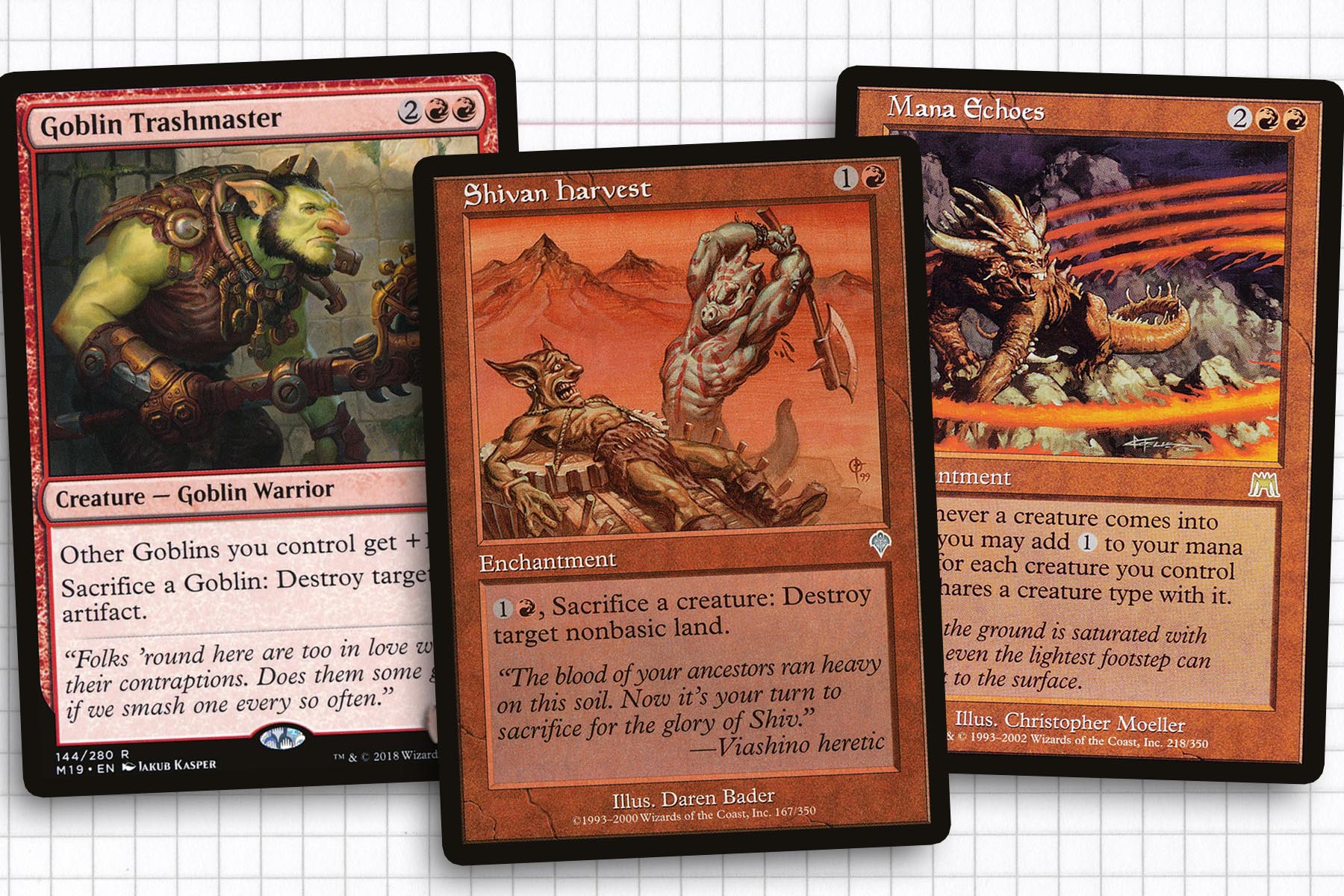
Never Going Out of Style
While I had built many decks before diving into Ib Halfheart, including Ertai, the Corrupted, Jhoira of the Ghitu, and The Mimeoplasm, the little goblin advisor is currently my oldest existing deck. I think that stems from my own stubbornness, openly disregarding that fiend Krenko, and recognizing the adaptability of Ib. As the world was progressing towards more complicated mana bases, I was simplifying everything and embracing Mountains. I ran Price of Progress, Shivan Harvest, and Ruination with little fear of backlash.
As time went on, I was collecting just about every explicit goblin lord I could get my hands on: Goblin Chieftain, Goblin King, Goblin Trashmaster, Goblin Warchief, and Hobgoblin Bandit Lord. In this way, it often feels like I am capturing some of the early days of Magic aesthetic, just collecting goblins and hoping that the lords will find their way to my hand eventually.
There is also the joy I get from envisioning the make-up of my ideal turn and going all in when it finally looks like it might have lined up. The play pattern is usually pretty explosive, usually with me sacrificing six to ten Mountains at the end of an opponent’s turn, maybe activating Krenko, Mob Boss, and casting Breath of Fury on my main phase. From there, the enchanted creature is sent at an open player, while the rest will swarm the most present threat. From there, most players cannot defend against a tidal wave of goblin tokens coming at them repeatedly.
I also suppose another reason why this deck has endured as long as it has is that it gets to play cards which admittedly could have a place in most commander decks, but have always been pet cards for my flavor of Goblins. Caterwauling Boggart often reads as a redundancy for Goblin War Drums; while that is certainly true, both cards really help Ib do his thing, forcing more blocks and allowing damage to spread quickly without my own forces being as rapidly diminished.
For a long time Mana Echoes was one of the most valuable cards in the deck, simply due to supply issues. Entering into the game during Onslaught and having a copy haphazardly really paid off in the end. While not a crucial piece of the deck, it is impactful in most games where it remains in play and off-sets the disadvantages that we commonly face, as our deck will often be sacrificing its basic lands, leaving us mana hungry.
On the flip side, Shivan Harvest has been called out more than once as the most threatening object on the battlefield. I think because land destruction is something that most players irrationally fear. In truth, I can use it to handle Kor Haven or Maze of Ith that may be impeding my clock, but I often don’t have the creature base to be policing the entire table. Regardless, it’s a tool that has never felt like a dead card, especially as mana bases have become increasingly gaining more utility.
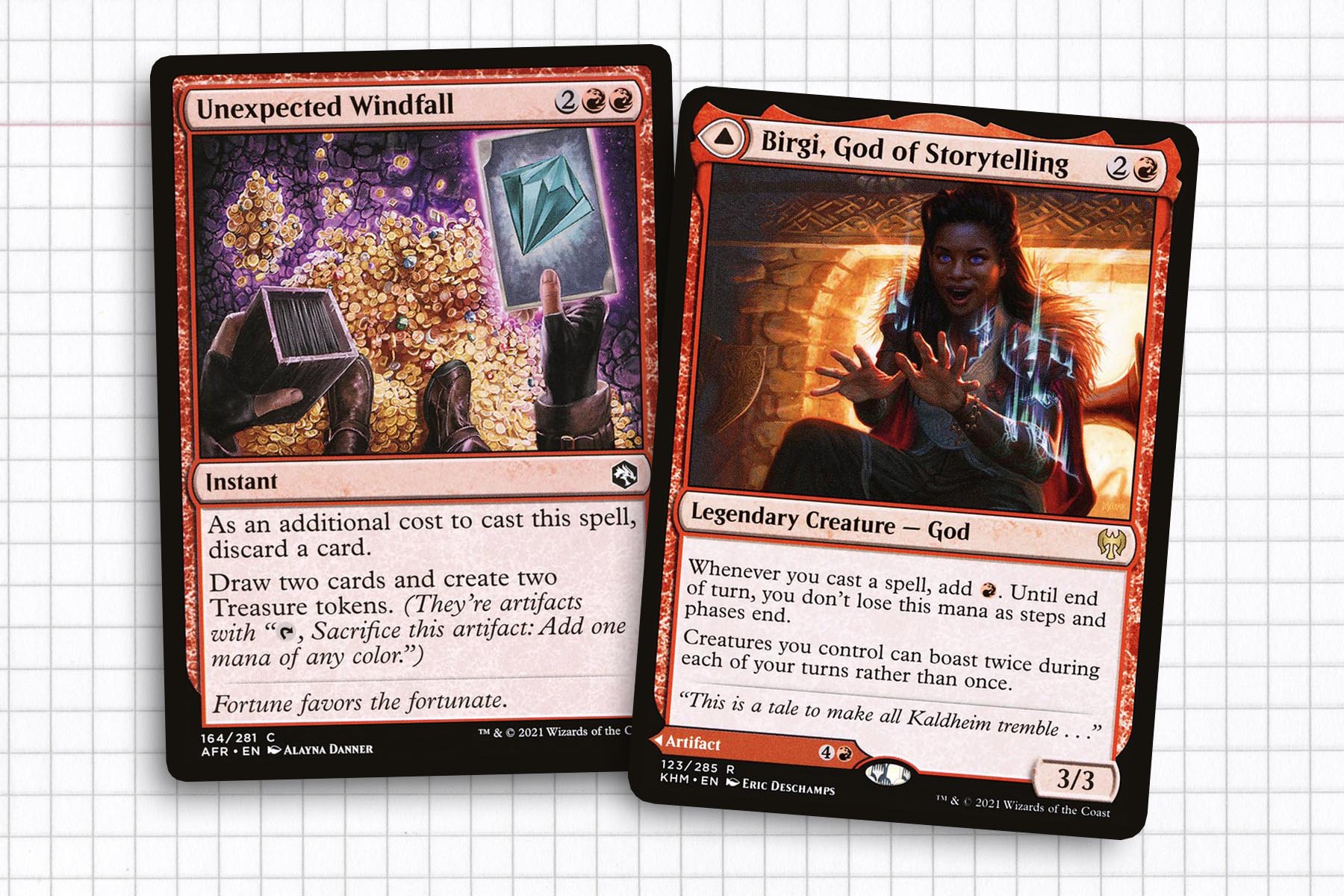
Strutting into 2022
As 2021 was trying to close, it had occurred to me that I had really been ignoring this deck in terms of evaluating new cards as possible additions. It is conceivable that two years had gone by since I added anything of considerable note and the changes to Red’s place in Magic were not being represented. I spent a great deal of time examining and reflecting on the deck, sorting out what cards were often not delivering on what I was looking to accomplish. This gave me a general idea of approximately how many new cards might be making their way into the deck.
I knew that the deck hadn’t been keeping up with the available drawing spells printed in the last few years, which is how Cathartic Pyre, Thrill of Possibility, and Unexpected Windfall got onto my radar. The deck lacked the reach I needed to either rebuild after mass removal or simply to close out games. Birgi, God of Storytelling was an early addition to fulfilling this role, but Neheb, Dreadhorde Champion started impressing me too, as they offered the mana burst I was looking for along with filtering out cards I didn’t need over the course of the game.
Even this small selection of card additions has proven to really invigorate the deck and make me want to play it more often than I was previously. I have, of course, stayed on the lookout and just haven’t had the time to acquire Spiteful Repossession, which could act as a tool similar to Surveyor’s Scope, allowing me to drop really low on lands without being entirely left hanging when my plans don’t all come together. Overall, I really enjoy where Ib sits today, be it the new additions or the classic pet cards.
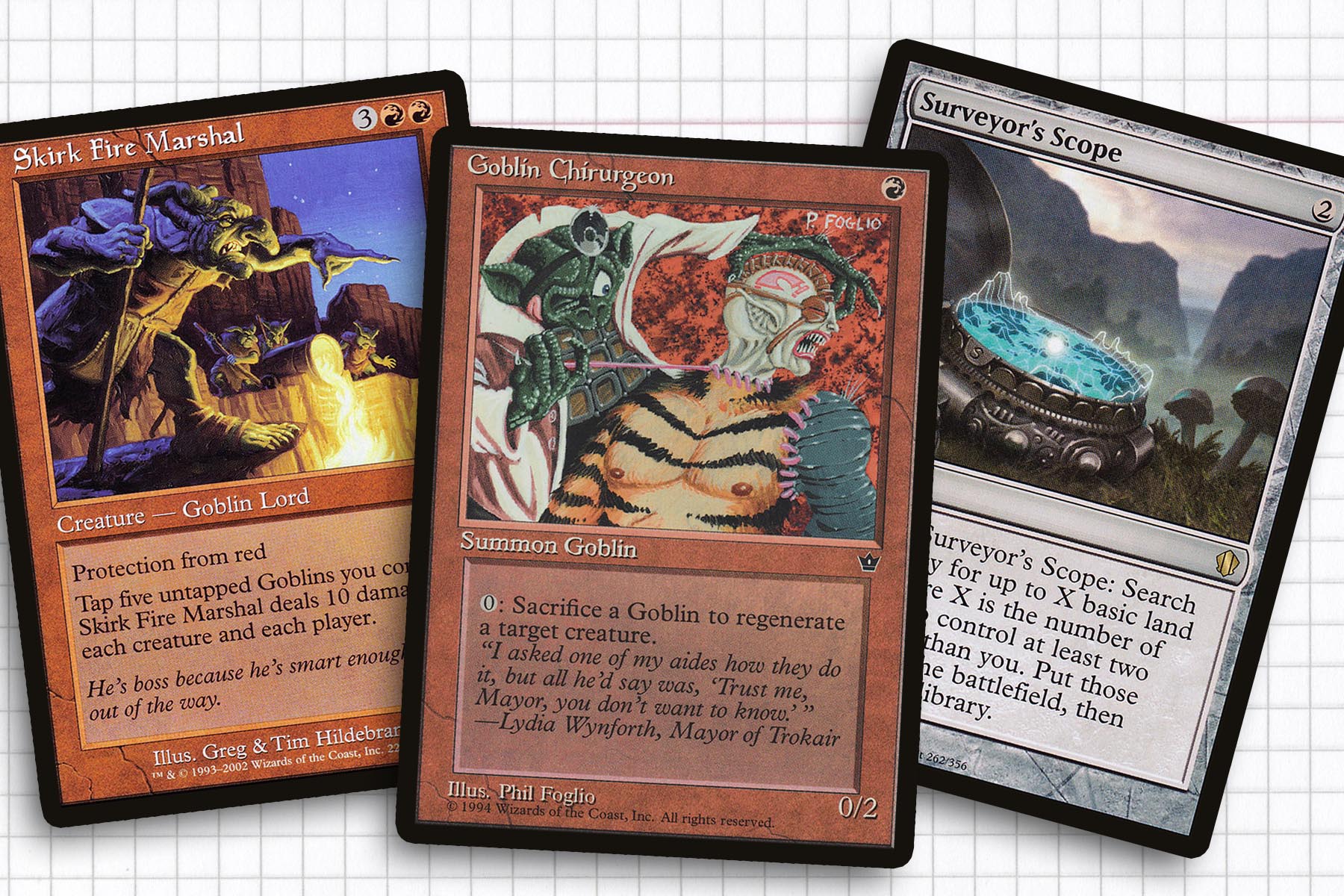
Remembering Tactics
Because Ib Halfheart lives off the beaten path, they get to use niche cards in a different context. Goblin Chirurgeon is such a long-forgotten card that any player who has seen it in their storied Magic career is giddy to have it in play and anyone discovering it for the first time is often beside themselves. The ability to protect creatures at the cost of what is often a token feels like such a color pie break, but at the same time entirely in the flavor of Goblins. In a similar way, Stingscourger is a strange color pie bend that often stirs up trouble in top deck situations.
It seems like Ghired’s Belligerence has really flown under the radar, probably because it is a populate card in a color less-known for its token strategies. In practice it has proven to be a reliable removal spell when it needs to be and a brilliant way to rebuild in scenarios where I creatures are going to be attrited over the course of the turn. Skirk Fire Marshal has proven to be a win condition if, and when I’ve crafted the game to the point where I am just slightly ahead on life. Often only needing to sacrifice the Mountains needed to allow repeated activations, the win condition usually requires minimal set up as well. There was a time when the deck featured Basilisk Collar, but since other combos made their way out of the deck, there were not enough repeatable uses to make it feel worth it.
Finally, Surveyor’s Scope serves as the most pet card in the entire deck. Prior to tapping into its potential, I was using Sword of the Animist, but found that the ramp it offered wasn’t as explosive as I needed. Ib Halfheart is playing for a critical turn, so being able to sacrifice most of my lands, only to tutor out two or three more back out will usually allow for activations or triggers needed to close out dwindling games.
At this point, I hope that I have demonstrated some of the fantastic parts of this laughable tribe. I really love this deck and it’s hard to imagine deconstructing it in an attempt to find the same satisfaction with a different general. As someone who entered into the game with Onslaught block, tribal strategies have been a hallmark of my experience with the game. In that way it is fitting that one of my favorite tribal decks happens to be one of the tribes that started it all at the very beginning. Thanks for reading.
Ryan Sainio is a Graphic Designer who writes about EDH and the EDH community. He has been playing Magic: the Gathering since 7th Edition in 2002 and values flavorful and fun gameplay over competitively optimized decks.

